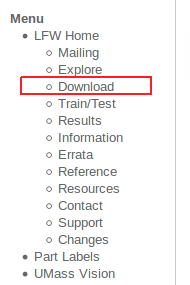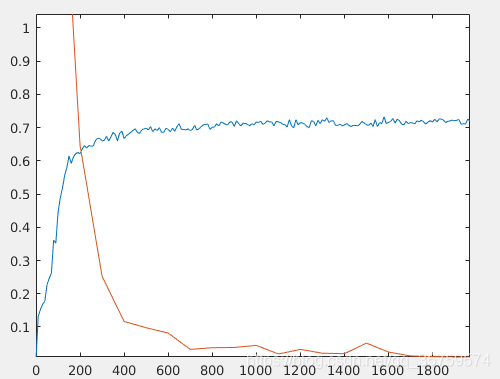这三四个月一直在用caffe训练,出现各种问题,所以写这篇文来记录一下这段时间的辛苦泪水。写的不好,请多多包涵。
目录
3.matlab绘制caffe训练后的log 中的loss曲线和accucy曲线
一、caffe的模型结构
1.网络结构配置文件:
训练网络结构 train.prototxt,
测试网络结构 test.prototxt,
实施网络结构 deploy.prototxt
2.网络权重参数文件
该文件用于保存网络各层的权重值,是以*.caffemodel格式存储的文件。而在运行中,其将以Blob数据形式存入内存中
3.训练超参数文件
用来控制网络训练及测试阶段的超参数,比如测试网络结构配置文件,梯度下降法中的批量、学习率、遗忘因子等参数,测试的间隔迭代次数等等,其同样是用*.prototxt的文件格式(比如solver.prototxt)
二、数据集
这里以lfw-aligned为例制作deepid2 lmdb数据集
1.下载数据集
去官网下载。
Download -> All images aligned with deep funneling


2.制作标签文件train.txt 和 val.txt
注意:train. txt 和 val.txt 中数据不能出现重叠,否则会出现过拟合现象
这里采用python来制作标签文件
最后将train. txt 和 val.txt 放到 lfw-aligned文件夹下
3.用脚本生成lmdb数据集
在caffe下创建run.sh,并运行
注意:数据集必须打乱 即: --shuffle=true
EXAMPLE=examples/deepid2
DATA=data/lfw-aligned/
TOOLS=build/tools
RESIZE_HEIGHT=55
RESIZE_WIDTH=47
echo "creating lmdb..."
rm -rf $EXAMPLE/DeepID2_train_lmdb
rm -rf $EXAMPLE/DeepID2_test_lmdb
$TOOLS/convert_imageset --shuffle=true \
--resize_height=$RESIZE_HEIGHT \
--resize_width=$RESIZE_WIDTH \
$DATA \
$DATA/train.txt \
$EXAMPLE/DeepID2_train_lmdb
$TOOLS/convert_imageset --shuffle=true \
--resize_height=$RESIZE_HEIGHT \
--resize_width=$RESIZE_WIDTH \
$DATA \
$DATA/val.txt \
$EXAMPLE/DeepID2_test_lmdb
echo "compute image mean..."
$TOOLS/compute_image_mean -backend=lmdb $EXAMPLE/DeepID2_train_lmdb \
$EXAMPLE/DeepID2_mean.proto
echo "done..."
sh run.sh三、训练
1.创建train.sh 脚本,并保存训练日志
#!/usr/bin/env sh
set -e
TOOLS=./build/tools
GLOG_logtostderr=0
GLOG_log_dir='./trainLog/deepID2/train.log'
$TOOLS/caffe train --solver=examples/deepid2/DeepID2_solver.prototxt $@ 2>&1 | tee $GLOG_log_dir2.调参
在solver.prototxt 文件中
test interval* train batch size 应该>=train image 总数
test iter * test batch size应该>=test image 总数
否则容易出现训练曲线震荡问题
如果loss不收敛,甚至出现 loss = nan 时,base_lr 调小一点,比如将 base_lr = 0.001 改为 base_lr = 0.0001
3.matlab绘制caffe训练后的log 中的loss曲线和accucy曲线
clc;
clear;
% load the log file of caffe model
fid = fopen('train.log', 'r');
tline = fgetl(fid); %get arrays to draw figures
accuracyIter = [0];%accuracy横坐标
accuracyArray = [];%accuracy纵坐标
lossIter = [];%loss横坐标
lossArray = [];%loss纵坐标
%record the last line
lastLine = ''; %read line
LLastLine = '';
while ischar(tline)
%%%%%%%%%%%%%% the accuracy line %%%%%%%%%%%%%%
k = strfind(tline, 'Test net output #0');
if (k)
k = strfind(tline, 'accuracy1');
if (k) % If the string contain test and accuracy at the same time % The bias from 'accuracy' to the float number
indexStart = k + 12;
indexEnd = size(tline);
str = tline(indexStart : indexEnd(2));
accuracyArray = [accuracyArray, str2num(str)];
end
% Get the number of index
k =strfind(lastLine, 'Restarting');
if (k)
lastLine = LLastLine;
end
k = strfind(lastLine, 'Iteration');
if (k)
indexStart = k + 10;
indexEnd = strfind(lastLine, ',');
str2 = lastLine(indexStart : indexEnd - 1);
accuracyIter = [accuracyIter, str2num(str2)];
end
% Concatenation of two string
res_str = strcat(str2, '/', str);
end
%%%%%%%%%%%%%% the loss line %%%%%%%%%%%%%%
k1 = strfind(tline, 'Iteration');
if (k1)
k2 = strfind(tline, 'loss');
if (k2)
indexStart = k2 + 7;
indexEnd = size(tline);
str1 = tline(indexStart:indexEnd(2));
indexStart = k1 + 10;
indexEnd = strfind(tline, '(') - 1;
str2 = tline(indexStart:indexEnd);
res_str1 = strcat(str2, '/', str1);
lossIter = [lossIter, str2num(str2)];
lossArray = [lossArray, str2num(str1)];
end
end
LLastLine = lastLine;
lastLine = tline;
tline = fgetl(fid);
end
%draw figure
figure;
plot(accuracyIter, accuracyArray);
%title('iteration vs accurancy'); %绘制accuracy曲线
hold on
plot(lossIter, lossArray);
%title('iteration vs loss'); %绘制loss曲线结果如下:(橘红色为loss曲线,蓝色为accuracy曲线,横坐标为iteration。训练的效果不好)









 本文详细记录了使用Caffe进行模型训练的过程,包括模型结构配置、数据集准备、训练日志分析与绘图,以及参数调整技巧。作者分享了在训练过程中遇到的问题与解决方案,为读者提供了宝贵的实践经验。
本文详细记录了使用Caffe进行模型训练的过程,包括模型结构配置、数据集准备、训练日志分析与绘图,以及参数调整技巧。作者分享了在训练过程中遇到的问题与解决方案,为读者提供了宝贵的实践经验。
















 3242
3242

 被折叠的 条评论
为什么被折叠?
被折叠的 条评论
为什么被折叠?








